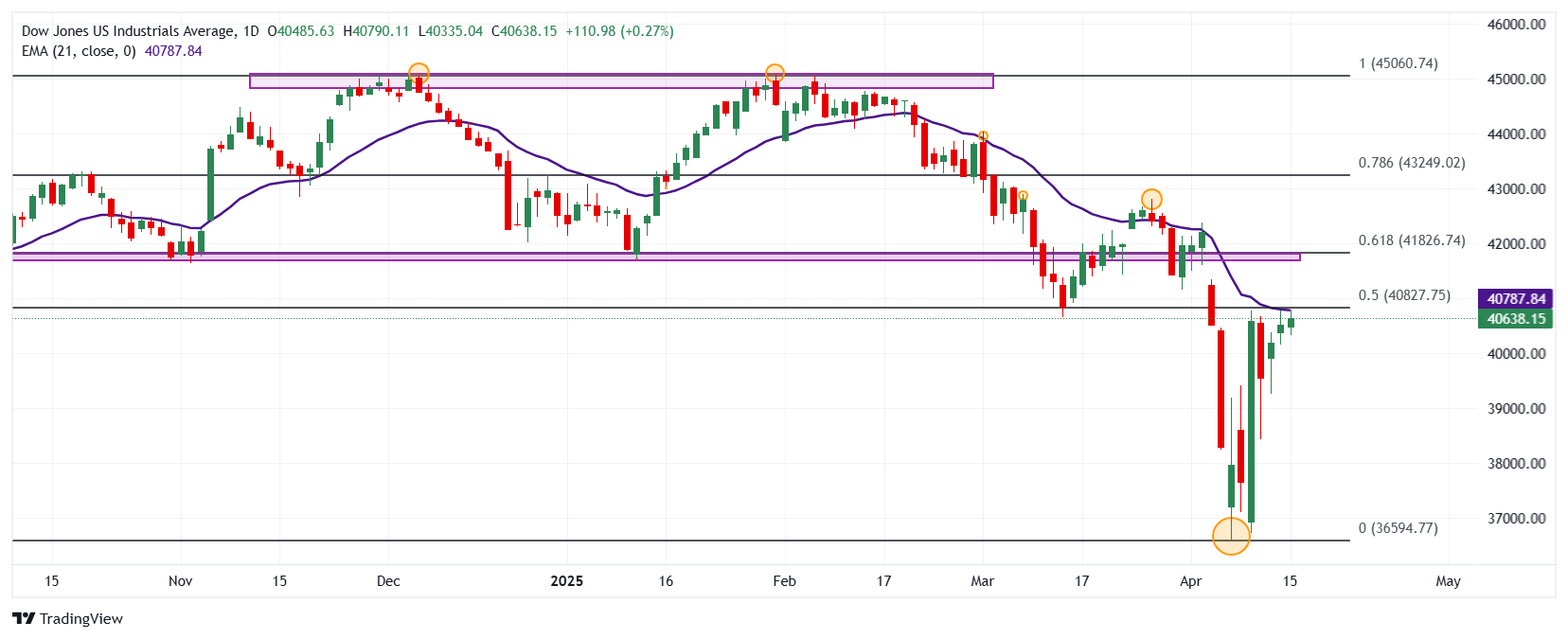- Dow Jones loses 0.37% in the day, currently operating at 40,377.
- The Nasdaq 100 wins 0.15% daily, animated by Netflix (NFLX).
- The S&P 500 decoced 0.19% on Tuesday, staying within Monday’s operational range.
- The Empire State manufacturing index is located at -8.1 points in April, following in the contraction zone.
- The attention of investors will be tomorrow at the speech of Jerome Powell, president of the Federal Reserve.
The Dow Jones established a minimum of the day in 40,335, found aggressive buyers who took the index to a daily maximum in 40,790.
The Dow Jones industrial average began negotiations in 40,485, while the Nasdaq 100 technological index began operating in 18,777. The S&P 500 opened in 5,398, extending its profits for the third consecutive occasion.
The Boeing Company and Caterpillar drag Dow Jones to negative territory
The Dow Jones index loses 0.37% daily, currently quoting about 40,377.
The Boeing Company titles (BA) fall 2.36% on Tuesday, reaching April 11 at $ 155.28, ending with two consecutive days upwards.
In the same tune, the values of Caterpillar (CAT) decrease 1.57% in the day, operating when writing about 293,43 $, extending the losses of yesterday.
The Dow Jones falls 150 points today, staying within the operational range that the previous session at 40,377.
The Nasdaq 100 extends its animated earnings by Netflix and Palantir Technologies
The Nasdaq 100 technological index rebounds 0.15% in the day, currently operating in 18,221.
The actions of Palantir Technologies (PLT) rise by 6.24%, quoting when writing about $ 97.25, spinning two consecutive days with profits.
Following the upward perspective, Netflix (NFLX) values earn 4.83% today, reaching maximums not seen since March 26 in 991.48 $ prior to the publication of its quarterly report on April 17. The market consensus expects NFLX to obtain income for 10.5 billion dollars and a gain per share of $ 5,672.
The Nasdaq 100 goes up 45 points today, establishing a daily maximum in 19.002, signing three consecutive upward sessions.
The S&P 500 ends the day with losses prior to Jerome Powell’s speech
The S&P 500 goes back 0.19%, currently quoting in 5,394, staying within the operational range of the previous session.
The Empire State Manufacturing Index improves analysts’ estimates by being at -8.1 points for April, from -20 observed in March and -14.5 estimated by analysts. However, this figure remains within the contraction zone.
The look of the investors will be put tomorrow in the statements of Jerome Powell, president of the Federal Reserve. The market will be attentive to comments on the rate of type cuts in the midst of tariff uncertainty.
The S&P 500 loses points, maintaining an upward target in the 5,600 area, round number close to the maximum of April 3.
Technical Analysis of Dow Jones
The Dow Jones reacted upwards from a short -term support given by the minimum of April 7 in 36,614. To the north, the closest resistance is located at 42,820 maximum of March 26. The next key resistance is observed at 45,068, pivot point of January 31.
Dow Jones daily graphics

Dow Jones Faqs
The Dow Jones Industrial Avenge, one of the oldest stock market indexes in the world, consists of the 30 most negotiated values in the United States. The index is weighted by the price instead of capitalization. It is calculated by adding the prices of the values that compose it and dividing them by a factor, currently 0.152. The index was founded by Charles Dow, also founder of the Wall Street Journal. In recent years it has been criticized for not being sufficiently representative, since it only follows 30 companies, unlike broader rates such as S&P 500.
There are many factors that promote the Dow Jones Industrial Average (DJIA) index. The main one is the added performance of the companies that compose it, revealed in the quarterly reports of business benefits. The American and world macroeconomic data also contribute, since they influence investor confidence. The level of interest rates, set by the Federal Reserve (FED), also influences the DJia, since it affects the cost of credit, on which many companies depend largely. Therefore, inflation can be a determining factor, as well as other parameters that influence the decisions of the Federal Reserve.
Dow’s theory is a method to identify the main trend of the stock market developed by Charles Dow. A key step is to compare the direction of the Dow Jones Industrial Avenge (DJIA) and the Dow Jones Transportation Average (DJTA) and just follow the trends in which both move in the same direction. The volume is a confirmation criterion. The theory uses elements of maximum and minimum analysis. Dow’s theory raises three phases of the trend: accumulation, when intelligent money begins to buy or sell; Public participation, when the general public joins the trend; and distribution, when intelligent money abandons the trend.
There are several ways to operate with the DJ. One of them is to use ETF that allow investors to negotiate the DJ as a single value, instead of having to buy shares of the 30 companies that compose it. An outstanding example is the SPDR Dow Jones Industrial Avenge ETF (day). Future contracts on the DJ allow the specular operators about the future value of the index and the options provide the right, but not the obligation, to buy or sell the index at a predetermined price in the future. Investment funds allow investors to buy a part of a diversified portfolio of DJ values, which provides exposure to global index.
Source: Fx Street
I am Joshua Winder, a senior-level journalist and editor at World Stock Market. I specialize in covering news related to the stock market and economic trends. With more than 8 years of experience in this field, I have become an expert in financial reporting.







